University Psychology Assignment: Sex and Gender, Research & Theories
VerifiedAdded on 2020/05/01
|7
|1202
|47
Homework Assignment
AI Summary
This psychology assignment delves into the multifaceted topic of sex and gender, providing a comprehensive overview of research methodologies, the Kinsey Scale, and various psychological theories. The assignment begins by outlining five primary research methods: case study, naturalistic observation, interview, survey, and experimental methods, detailing their descriptions, benefits, and drawbacks. It then examines the Kinsey Scale, discussing its purpose, the limitations, and its use in studying sexuality. The assignment further explores several influential theories, including psychoanalytic, feminist, sociocultural, evolutionary, and learning theories, analyzing their perspectives on the development of gender differences. References from key sources are provided, offering a well-rounded understanding of the subject matter.

Running header: Sex and Gender 1
Sex and Gender
Student’s name
University
Sex and Gender
Student’s name
University
Paraphrase This Document
Need a fresh take? Get an instant paraphrase of this document with our AI Paraphraser
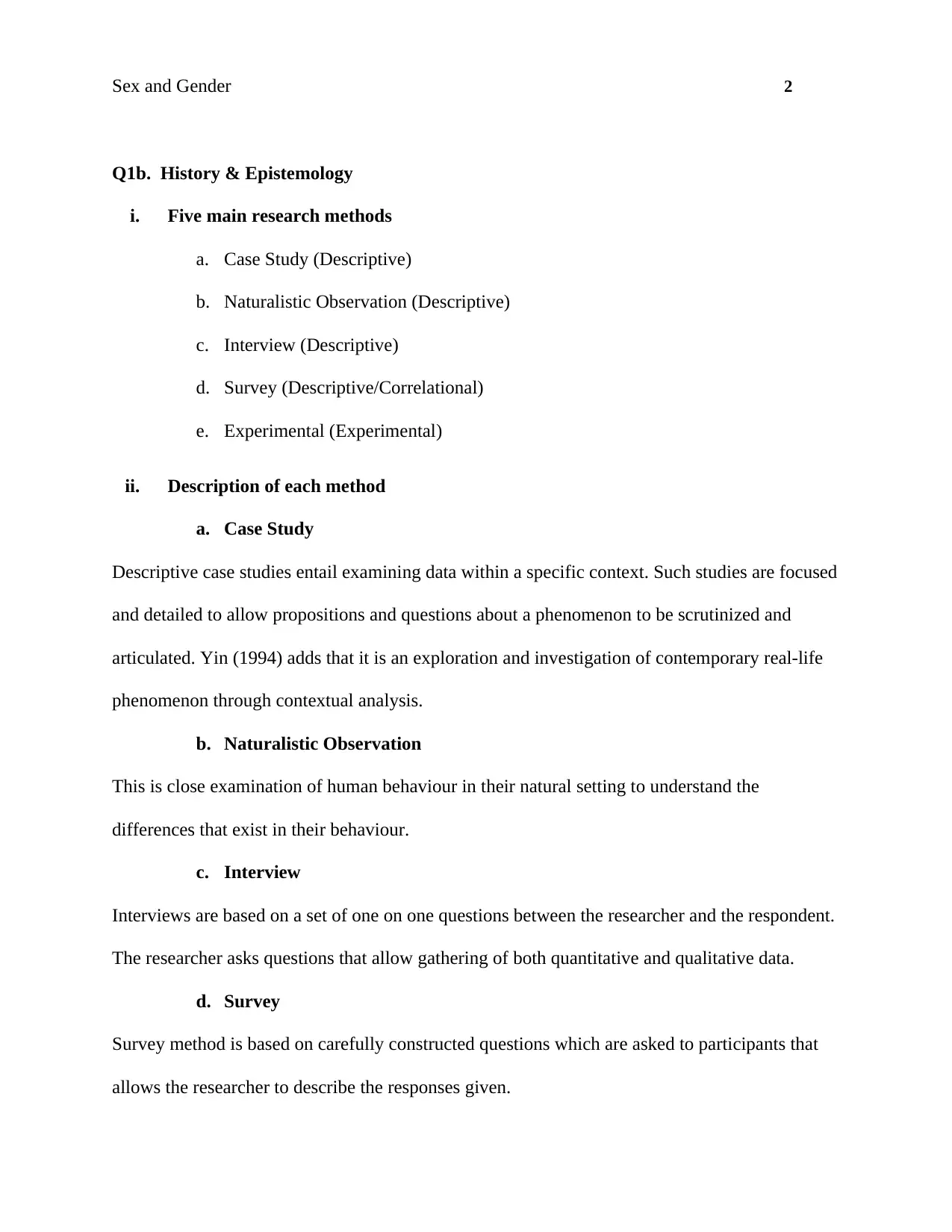
Sex and Gender 2
Q1b. History & Epistemology
i. Five main research methods
a. Case Study (Descriptive)
b. Naturalistic Observation (Descriptive)
c. Interview (Descriptive)
d. Survey (Descriptive/Correlational)
e. Experimental (Experimental)
ii. Description of each method
a. Case Study
Descriptive case studies entail examining data within a specific context. Such studies are focused
and detailed to allow propositions and questions about a phenomenon to be scrutinized and
articulated. Yin (1994) adds that it is an exploration and investigation of contemporary real-life
phenomenon through contextual analysis.
b. Naturalistic Observation
This is close examination of human behaviour in their natural setting to understand the
differences that exist in their behaviour.
c. Interview
Interviews are based on a set of one on one questions between the researcher and the respondent.
The researcher asks questions that allow gathering of both quantitative and qualitative data.
d. Survey
Survey method is based on carefully constructed questions which are asked to participants that
allows the researcher to describe the responses given.
Q1b. History & Epistemology
i. Five main research methods
a. Case Study (Descriptive)
b. Naturalistic Observation (Descriptive)
c. Interview (Descriptive)
d. Survey (Descriptive/Correlational)
e. Experimental (Experimental)
ii. Description of each method
a. Case Study
Descriptive case studies entail examining data within a specific context. Such studies are focused
and detailed to allow propositions and questions about a phenomenon to be scrutinized and
articulated. Yin (1994) adds that it is an exploration and investigation of contemporary real-life
phenomenon through contextual analysis.
b. Naturalistic Observation
This is close examination of human behaviour in their natural setting to understand the
differences that exist in their behaviour.
c. Interview
Interviews are based on a set of one on one questions between the researcher and the respondent.
The researcher asks questions that allow gathering of both quantitative and qualitative data.
d. Survey
Survey method is based on carefully constructed questions which are asked to participants that
allows the researcher to describe the responses given.
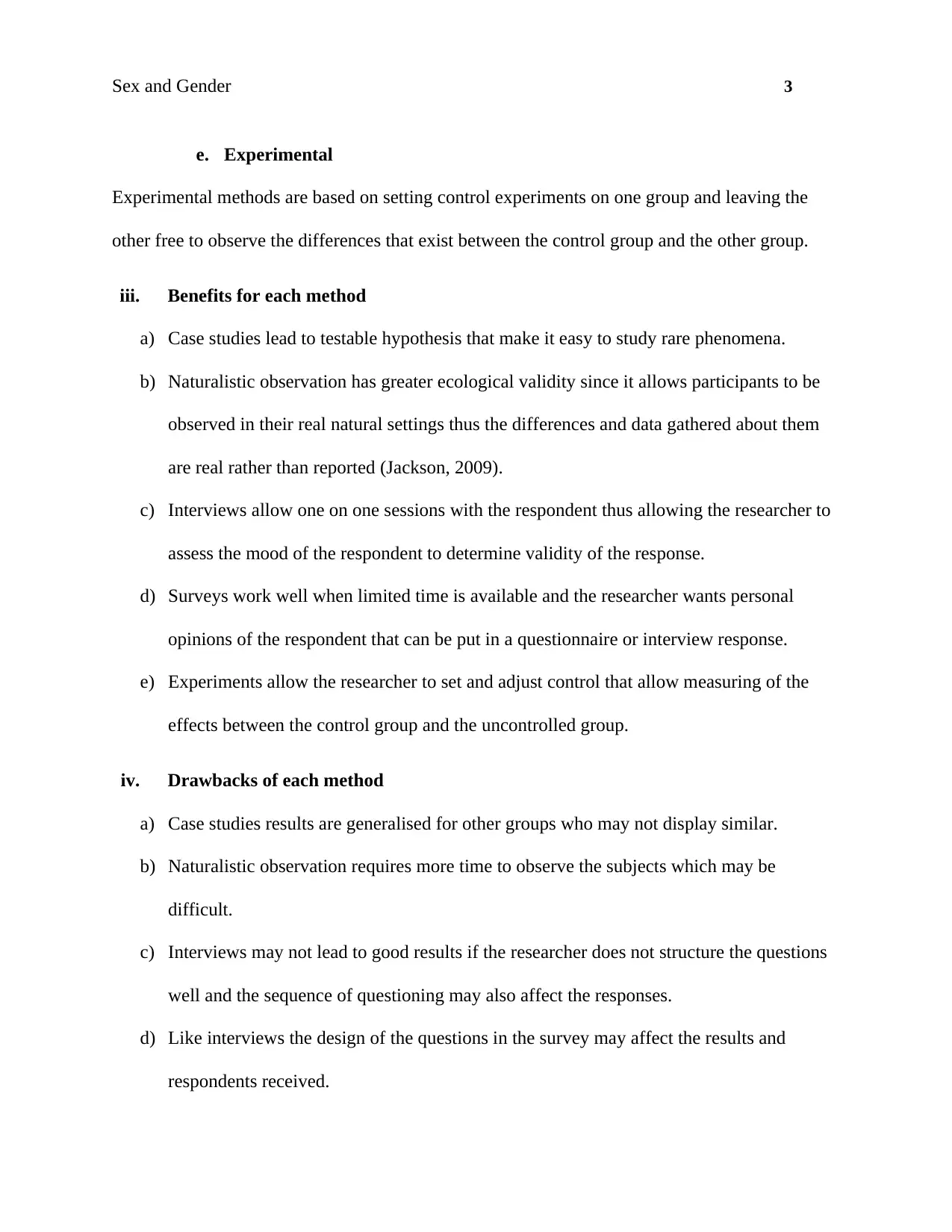
Sex and Gender 3
e. Experimental
Experimental methods are based on setting control experiments on one group and leaving the
other free to observe the differences that exist between the control group and the other group.
iii. Benefits for each method
a) Case studies lead to testable hypothesis that make it easy to study rare phenomena.
b) Naturalistic observation has greater ecological validity since it allows participants to be
observed in their real natural settings thus the differences and data gathered about them
are real rather than reported (Jackson, 2009).
c) Interviews allow one on one sessions with the respondent thus allowing the researcher to
assess the mood of the respondent to determine validity of the response.
d) Surveys work well when limited time is available and the researcher wants personal
opinions of the respondent that can be put in a questionnaire or interview response.
e) Experiments allow the researcher to set and adjust control that allow measuring of the
effects between the control group and the uncontrolled group.
iv. Drawbacks of each method
a) Case studies results are generalised for other groups who may not display similar.
b) Naturalistic observation requires more time to observe the subjects which may be
difficult.
c) Interviews may not lead to good results if the researcher does not structure the questions
well and the sequence of questioning may also affect the responses.
d) Like interviews the design of the questions in the survey may affect the results and
respondents received.
e. Experimental
Experimental methods are based on setting control experiments on one group and leaving the
other free to observe the differences that exist between the control group and the other group.
iii. Benefits for each method
a) Case studies lead to testable hypothesis that make it easy to study rare phenomena.
b) Naturalistic observation has greater ecological validity since it allows participants to be
observed in their real natural settings thus the differences and data gathered about them
are real rather than reported (Jackson, 2009).
c) Interviews allow one on one sessions with the respondent thus allowing the researcher to
assess the mood of the respondent to determine validity of the response.
d) Surveys work well when limited time is available and the researcher wants personal
opinions of the respondent that can be put in a questionnaire or interview response.
e) Experiments allow the researcher to set and adjust control that allow measuring of the
effects between the control group and the uncontrolled group.
iv. Drawbacks of each method
a) Case studies results are generalised for other groups who may not display similar.
b) Naturalistic observation requires more time to observe the subjects which may be
difficult.
c) Interviews may not lead to good results if the researcher does not structure the questions
well and the sequence of questioning may also affect the responses.
d) Like interviews the design of the questions in the survey may affect the results and
respondents received.
⊘ This is a preview!⊘
Do you want full access?
Subscribe today to unlock all pages.

Trusted by 1+ million students worldwide
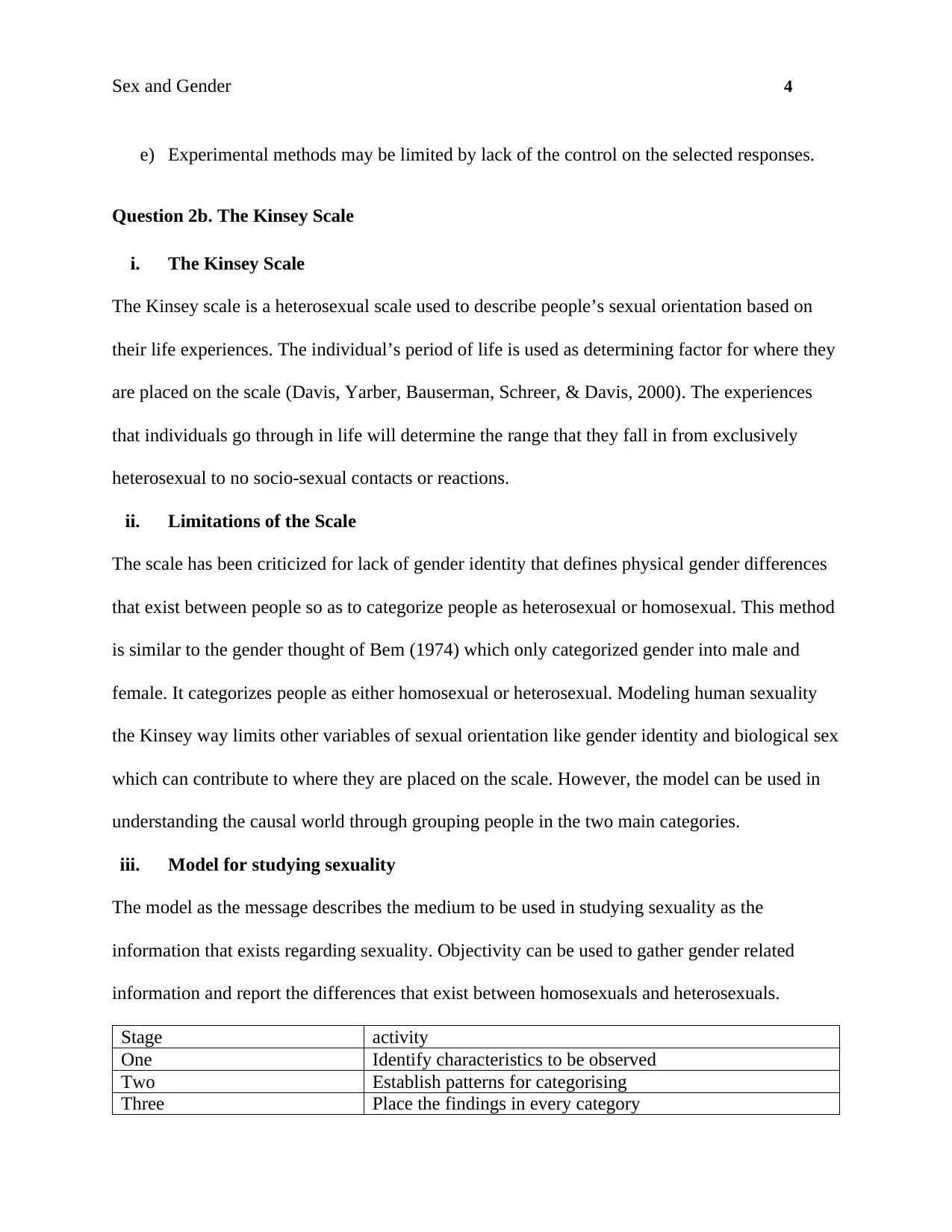
Sex and Gender 4
e) Experimental methods may be limited by lack of the control on the selected responses.
Question 2b. The Kinsey Scale
i. The Kinsey Scale
The Kinsey scale is a heterosexual scale used to describe people’s sexual orientation based on
their life experiences. The individual’s period of life is used as determining factor for where they
are placed on the scale (Davis, Yarber, Bauserman, Schreer, & Davis, 2000). The experiences
that individuals go through in life will determine the range that they fall in from exclusively
heterosexual to no socio-sexual contacts or reactions.
ii. Limitations of the Scale
The scale has been criticized for lack of gender identity that defines physical gender differences
that exist between people so as to categorize people as heterosexual or homosexual. This method
is similar to the gender thought of Bem (1974) which only categorized gender into male and
female. It categorizes people as either homosexual or heterosexual. Modeling human sexuality
the Kinsey way limits other variables of sexual orientation like gender identity and biological sex
which can contribute to where they are placed on the scale. However, the model can be used in
understanding the causal world through grouping people in the two main categories.
iii. Model for studying sexuality
The model as the message describes the medium to be used in studying sexuality as the
information that exists regarding sexuality. Objectivity can be used to gather gender related
information and report the differences that exist between homosexuals and heterosexuals.
Stage activity
One Identify characteristics to be observed
Two Establish patterns for categorising
Three Place the findings in every category
e) Experimental methods may be limited by lack of the control on the selected responses.
Question 2b. The Kinsey Scale
i. The Kinsey Scale
The Kinsey scale is a heterosexual scale used to describe people’s sexual orientation based on
their life experiences. The individual’s period of life is used as determining factor for where they
are placed on the scale (Davis, Yarber, Bauserman, Schreer, & Davis, 2000). The experiences
that individuals go through in life will determine the range that they fall in from exclusively
heterosexual to no socio-sexual contacts or reactions.
ii. Limitations of the Scale
The scale has been criticized for lack of gender identity that defines physical gender differences
that exist between people so as to categorize people as heterosexual or homosexual. This method
is similar to the gender thought of Bem (1974) which only categorized gender into male and
female. It categorizes people as either homosexual or heterosexual. Modeling human sexuality
the Kinsey way limits other variables of sexual orientation like gender identity and biological sex
which can contribute to where they are placed on the scale. However, the model can be used in
understanding the causal world through grouping people in the two main categories.
iii. Model for studying sexuality
The model as the message describes the medium to be used in studying sexuality as the
information that exists regarding sexuality. Objectivity can be used to gather gender related
information and report the differences that exist between homosexuals and heterosexuals.
Stage activity
One Identify characteristics to be observed
Two Establish patterns for categorising
Three Place the findings in every category
Paraphrase This Document
Need a fresh take? Get an instant paraphrase of this document with our AI Paraphraser
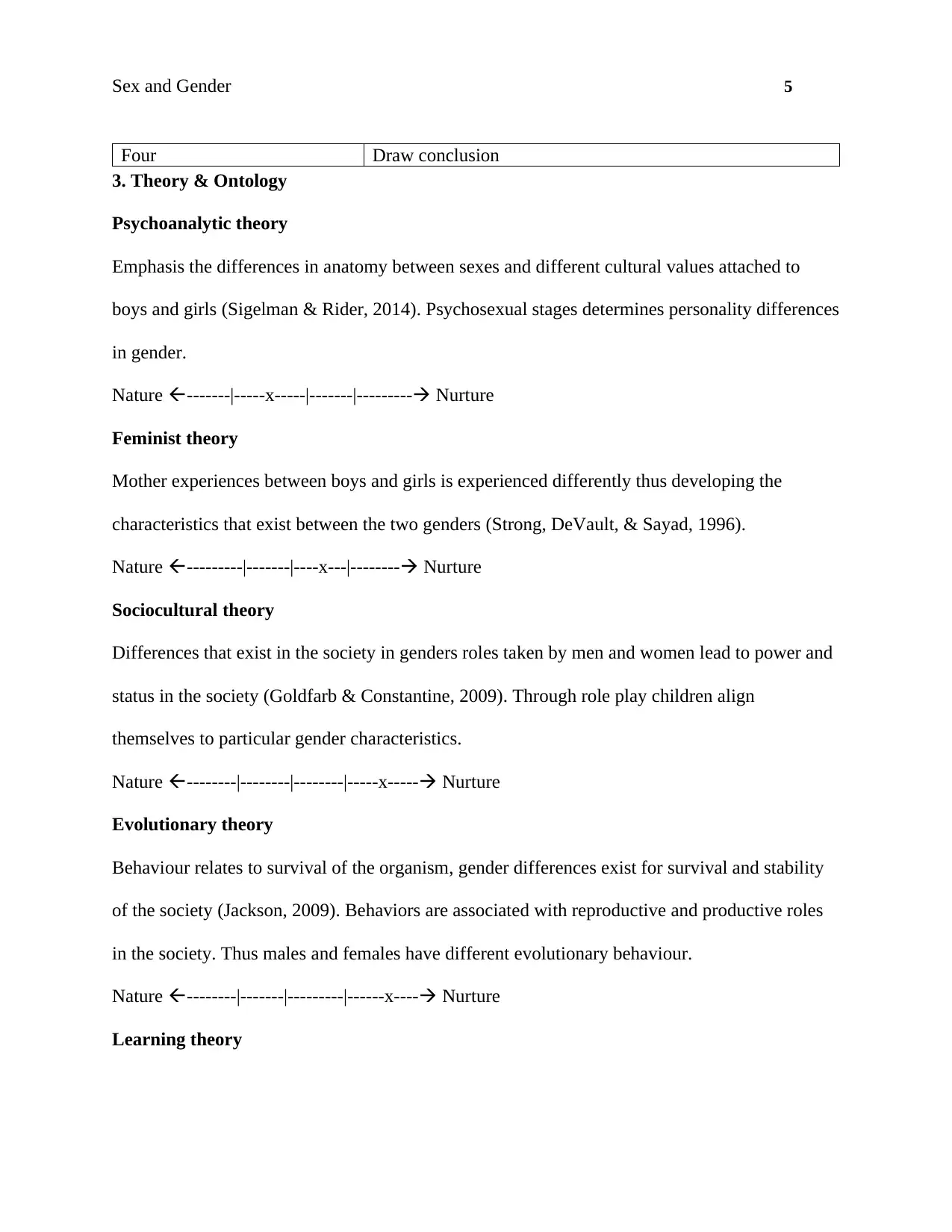
Sex and Gender 5
Four Draw conclusion
3. Theory & Ontology
Psychoanalytic theory
Emphasis the differences in anatomy between sexes and different cultural values attached to
boys and girls (Sigelman & Rider, 2014). Psychosexual stages determines personality differences
in gender.
Nature -------|-----x-----|-------|--------- Nurture
Feminist theory
Mother experiences between boys and girls is experienced differently thus developing the
characteristics that exist between the two genders (Strong, DeVault, & Sayad, 1996).
Nature ---------|-------|----x---|-------- Nurture
Sociocultural theory
Differences that exist in the society in genders roles taken by men and women lead to power and
status in the society (Goldfarb & Constantine, 2009). Through role play children align
themselves to particular gender characteristics.
Nature --------|--------|--------|-----x----- Nurture
Evolutionary theory
Behaviour relates to survival of the organism, gender differences exist for survival and stability
of the society (Jackson, 2009). Behaviors are associated with reproductive and productive roles
in the society. Thus males and females have different evolutionary behaviour.
Nature --------|-------|---------|------x---- Nurture
Learning theory
Four Draw conclusion
3. Theory & Ontology
Psychoanalytic theory
Emphasis the differences in anatomy between sexes and different cultural values attached to
boys and girls (Sigelman & Rider, 2014). Psychosexual stages determines personality differences
in gender.
Nature -------|-----x-----|-------|--------- Nurture
Feminist theory
Mother experiences between boys and girls is experienced differently thus developing the
characteristics that exist between the two genders (Strong, DeVault, & Sayad, 1996).
Nature ---------|-------|----x---|-------- Nurture
Sociocultural theory
Differences that exist in the society in genders roles taken by men and women lead to power and
status in the society (Goldfarb & Constantine, 2009). Through role play children align
themselves to particular gender characteristics.
Nature --------|--------|--------|-----x----- Nurture
Evolutionary theory
Behaviour relates to survival of the organism, gender differences exist for survival and stability
of the society (Jackson, 2009). Behaviors are associated with reproductive and productive roles
in the society. Thus males and females have different evolutionary behaviour.
Nature --------|-------|---------|------x---- Nurture
Learning theory
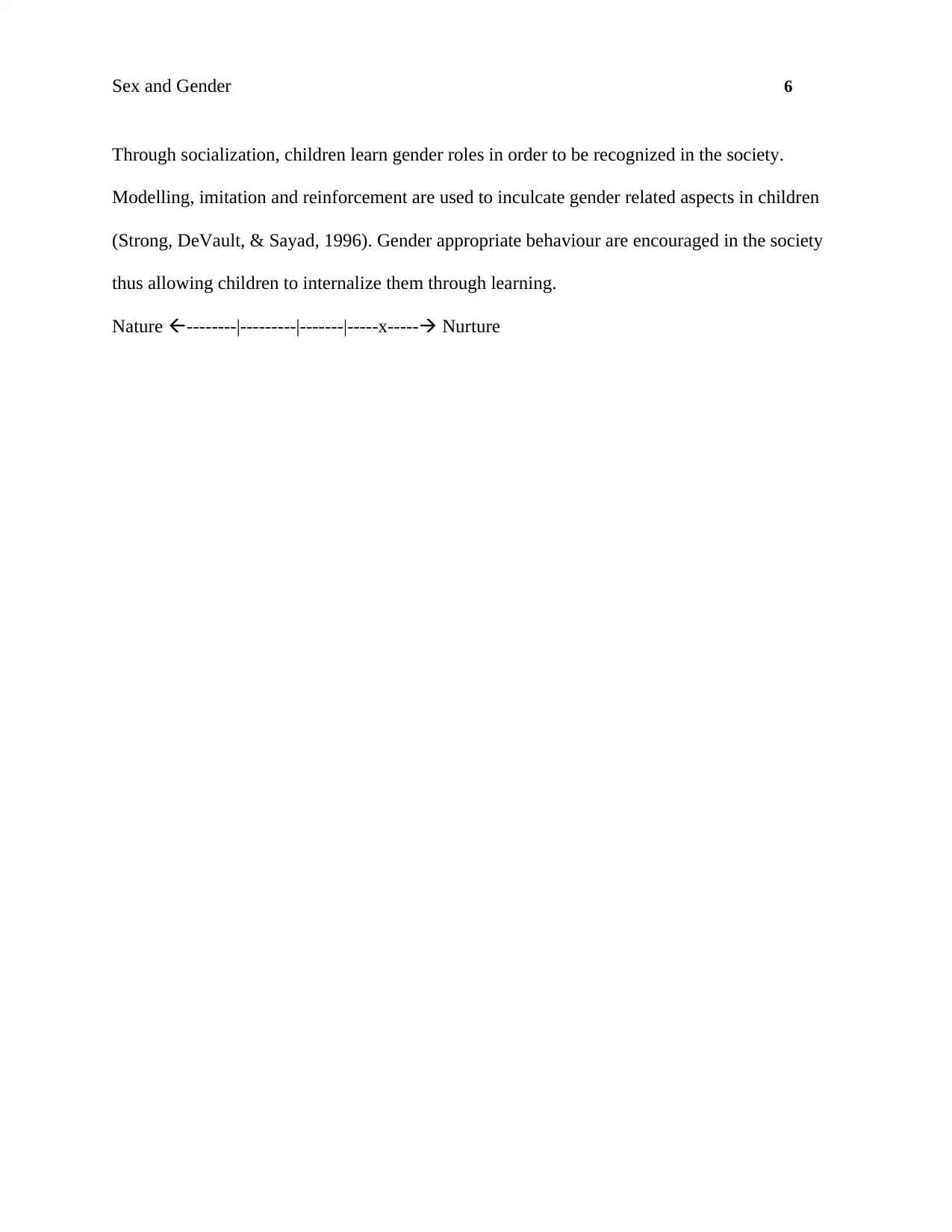
Sex and Gender 6
Through socialization, children learn gender roles in order to be recognized in the society.
Modelling, imitation and reinforcement are used to inculcate gender related aspects in children
(Strong, DeVault, & Sayad, 1996). Gender appropriate behaviour are encouraged in the society
thus allowing children to internalize them through learning.
Nature --------|---------|-------|-----x----- Nurture
Through socialization, children learn gender roles in order to be recognized in the society.
Modelling, imitation and reinforcement are used to inculcate gender related aspects in children
(Strong, DeVault, & Sayad, 1996). Gender appropriate behaviour are encouraged in the society
thus allowing children to internalize them through learning.
Nature --------|---------|-------|-----x----- Nurture
⊘ This is a preview!⊘
Do you want full access?
Subscribe today to unlock all pages.

Trusted by 1+ million students worldwide
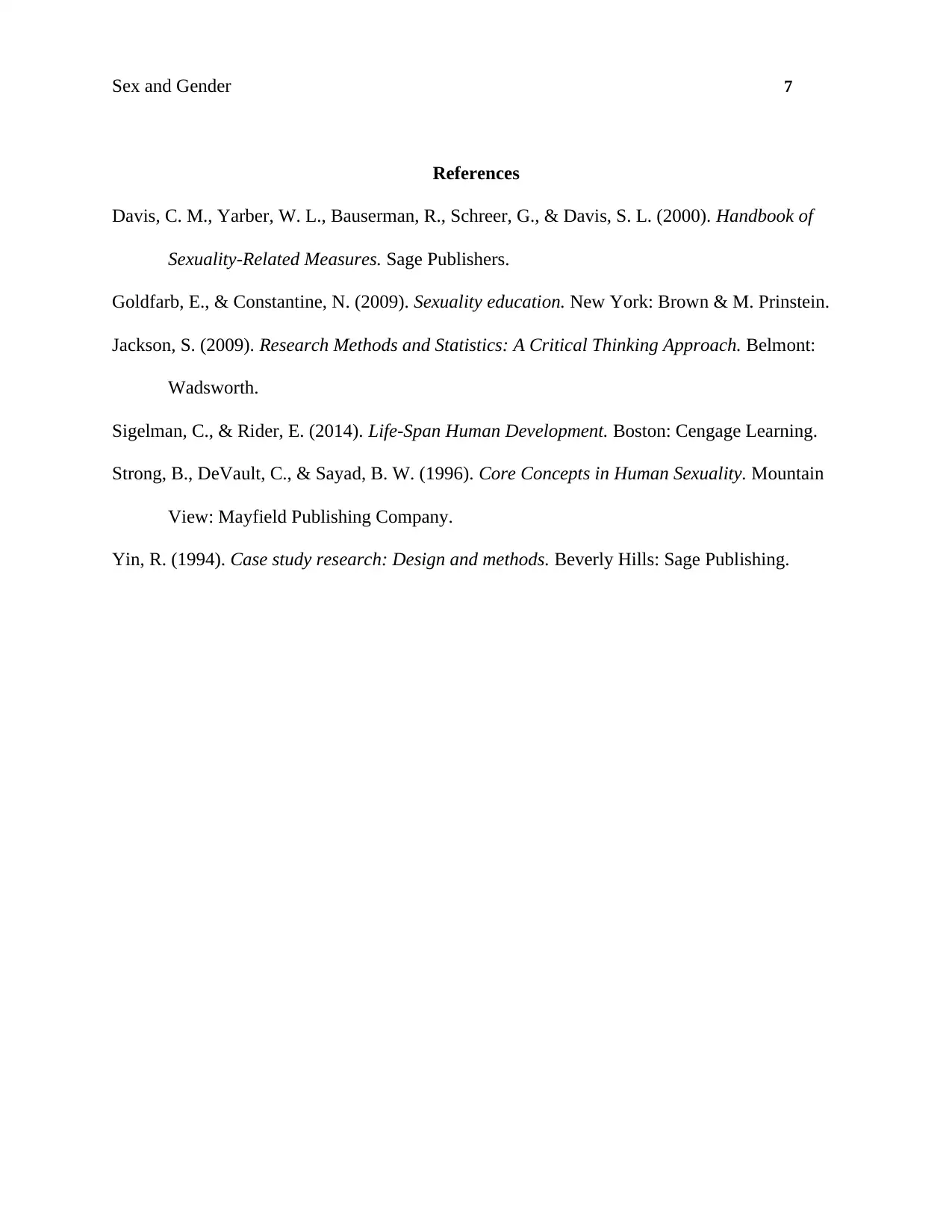
Sex and Gender 7
References
Davis, C. M., Yarber, W. L., Bauserman, R., Schreer, G., & Davis, S. L. (2000). Handbook of
Sexuality-Related Measures. Sage Publishers.
Goldfarb, E., & Constantine, N. (2009). Sexuality education. New York: Brown & M. Prinstein.
Jackson, S. (2009). Research Methods and Statistics: A Critical Thinking Approach. Belmont:
Wadsworth.
Sigelman, C., & Rider, E. (2014). Life-Span Human Development. Boston: Cengage Learning.
Strong, B., DeVault, C., & Sayad, B. W. (1996). Core Concepts in Human Sexuality. Mountain
View: Mayfield Publishing Company.
Yin, R. (1994). Case study research: Design and methods. Beverly Hills: Sage Publishing.
References
Davis, C. M., Yarber, W. L., Bauserman, R., Schreer, G., & Davis, S. L. (2000). Handbook of
Sexuality-Related Measures. Sage Publishers.
Goldfarb, E., & Constantine, N. (2009). Sexuality education. New York: Brown & M. Prinstein.
Jackson, S. (2009). Research Methods and Statistics: A Critical Thinking Approach. Belmont:
Wadsworth.
Sigelman, C., & Rider, E. (2014). Life-Span Human Development. Boston: Cengage Learning.
Strong, B., DeVault, C., & Sayad, B. W. (1996). Core Concepts in Human Sexuality. Mountain
View: Mayfield Publishing Company.
Yin, R. (1994). Case study research: Design and methods. Beverly Hills: Sage Publishing.
1 out of 7
Related Documents
Your All-in-One AI-Powered Toolkit for Academic Success.
+13062052269
info@desklib.com
Available 24*7 on WhatsApp / Email
![[object Object]](/_next/static/media/star-bottom.7253800d.svg)
Unlock your academic potential
Copyright © 2020–2025 A2Z Services. All Rights Reserved. Developed and managed by ZUCOL.





